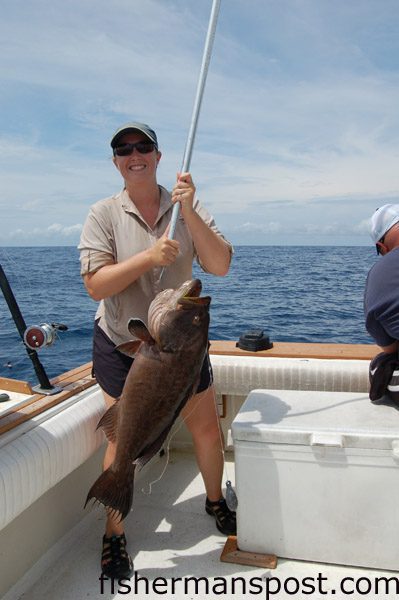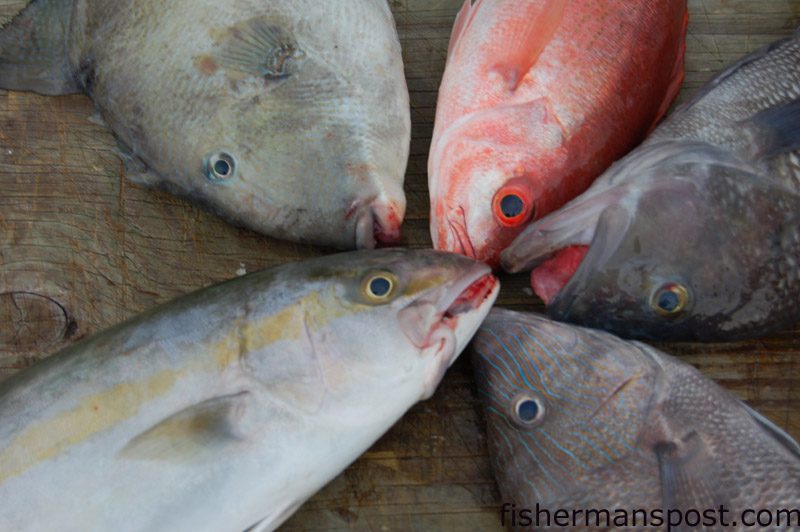Guide Time – Long Bay Bottom Bounce

Fisherman’s Post Layout and Marketing Manager Sarah Gilliam with her first legal grouper, an 18 lb. scamp that bit a squid/cut bait combo at a live bottom off Lockwood Folly Inlet in 100′ of water. She was fishing with Capt. Ryan Jordan and mate Billy Stockdale on the charterboat “Fugitive” out of Blue Water Point Marina.
“I like to power-drift these spots,” Capt. Ryan Jordan explained as he eyed the green and red dashes and blobs showing up over the bottom line on his sonar. “So I’m going to set us up over the fish before you guys drop and try to hold us over them.”
Moments later, as we watched the scattered marks turn into a much more solid mass, he gave the word, and Publisher Gary Hurley, Sales Manager Joshua Alexander, Layout/Marketing Manager Sarah Gilliam (making her first appearance on a Fish Post trip), and I (Editor) sent the 16 oz. sinkers on our rigs plummeting to the seafloor 90’ below.
We’d hopped aboard Jordan’s boat, the 33’ Morgan sportfisherman “Fugitive,” early that morning at Oak Island’s Blue Water Point Marina, eager to fill some coolers with a variety of the delicious bottom feeders that make their homes on the offshore reefs and wrecks of Long Bay.
None of us were more eager than Gary, who’d suffered the loss of a chest freezer packed with fillets earlier that summer after a contractor knocked the plug from the wall. Since those fillets often lead to Fisherman’s Post parties/fish fries at his waterfront house, I was certainly ready to do my part to replenish the stock, not to mention bring home some tasty meals myself.
Ryan’s mate Billy Stockdale had set us all up with 4/0 outfits and double-drop “chicken” rigs baited with squid and cut baits, and the combination didn’t take long to attract some attention.
Fittingly, Gary was first to hook up, and produced a pair of well-undersized black sea bass when he brought his rig to the surface.
Rain had begun falling about the same time as our rigs, and as the drizzle turned into a downpour, I became acutely aware that my rain jacket no longer earned its name, as I was soaked through in seconds when the shower intensified.
Retreating into the cabin to shed the saturated jacket, I noted Josh and Sarah were swinging their own short sea bass over the gunnel.
“Looks like just little ones here,” Ryan said from the helm. “Keep them up when you guys reel in again, and we’re going to push a little bit further offshore.”
Moments later, the captain pointed his bow back to the south, throttled up the boat’s diesel engine, and we motored another few miles offshore, thankfully away from the cloud that had parked itself over our first spot.
“See,” Ryan explained. “If we’d anchored up there, that would’ve taken at least 45 minutes to set up, find out there was nothing but small stuff, and get moving again.”
The diesel soon slowed again, and Ryan was immersed in his depthfinder, scanning the area before positioning the boat over the best sonar show and issuing the go-ahead to send the rigs back into the depths.
“We’re closer to 100’ here,” he explained. “I’m marking some stuff up off the bottom that might be beeliners, so you might want to reel up 5-10 turns and see.”
It took even less time for the action to commence at this spot, and these fish weren’t going back into the water.
Black sea bass, grunts, and, indeed, a beeliner (vermillion snapper) came over the rails as our initial drops came back up, and better yet, all were legal and bound for the fish box. Subsequent drops were equally or more productive, keeping Billy occupied unhooking fish, cutting bait, and keeping track of what we were putting in the fish box so as not to exceed any bag limits.

A sampling of some of the tasty bottom fish available to anglers dropping baits to offshore structure in Long Bay, including a banded rudderfish, triggerfish, beeliners, black sea bass, and white grunts. All attacked squid and cut baits on double drop bottom rigs while the Fisherman’s Post crew was on an offshore trip with Capt. Ryan Jordan of Fugitive Charters.
“We drifted off of them a little bit,” Ryan said after the bite slowed around four drops in. “Keep them up and I’m going to put us back on the fish.”
We got right back to business after he executed a quick reposition from the helm, and some red porgies (“pinkies” or “silver snapper” in local parlance) joined in on the action, identifying themselves by a spastic, jerky resistance long before they reached the surface.
Ryan repositioned us on the fish several more times before the bite slowed in earnest, but he wasn’t discouraged.
“We’re going to another little spot really close to here,” he said after we’d cranked up our rigs and secured our weights. “Billy, leave the light-line out.”
The mate had been quietly fishing a live bait outfit with a free-lined cigar minnow while we went to work on the bottomfish, and the minnow skipped in the boat’s wake as Ryan slowly eased over to another spot less than a half-mile away.
“Definitely marking some beeliners now,” the captain said as he positioned us over the bright slashes on the sonar screen, “about 10 turns off the bottom.”
Letting the sinker thump the seafloor and then winding up a few feet confirmed the captain’s hypothesis, and these were a better class than the first we’d landed—solid 2 lb. fish that weren’t at all shy about attacking pieces of squid, false albacore, menhaden, and the other baits Billy kept slicing and refilling our individual buckets with.
The beeliners are also some of the most striking of the offshore bottom feeders—their sleek, red-orange bodies terminating in huge eyes at one end and long, deeply-forked tails at the other. Oh, and they happen to be delicious.
Fat beeliners were present at our next spot as well, and the formula held up. Leave the bait on the bottom and immediately hook 1-2 grunts, sea bass, or pinkies—crank it a few turns towards the surface, wait for a nibble, and wind up a beeliner.
A few sharks had given us a bit more of a pull than the bottomfish we were steadily adding to the cooler, but I soon heard a grunt come out of a human, rather than a fish, and looked over to see Gary pinned to the rail, his rod tip bucking as he attempted to lift the fish and gain some line. The battle was locked in a stalemate for a few moments, but soon the fish succumbed to the screwed-down drag on the Penn Senator and the Publisher was able to earn a few feet of monofilament back. The fish proved its will wasn’t broken directly, though, pulling the rod back to the gunnel and eliciting a few more grunts from its adversary.
We’d been hoping the angry animal below was a grouper, but the battle didn’t lose any intensity even as the fish reached the upper half of the water column. When we finally saw some color in the blue water under the Morgan’s hull, it confirmed our suspicions, and Billy was soon hauling a 30 lb.-class amberjack over the rail.
“Oh yeah, we’re marking them now,” Ryan said from the helm, and the vivid slashes on the sonar display showed off a school of large fish extending 30’ up from the seafloor.
Joshua’s number was called next, and he went through a similar, though noisier struggle before putting his own jack on deck 5 minutes after his rod doubled towards the ocean.
We each got a turn over the next quarter hour (some more than once), bowing up on one of the jacks and grunting and panting our way through our own battles with the appropriately-nicknamed “reef donkeys.”
Those who weren’t fighting jacks continued adding to the significant collection of bottomfish we were amassing in the starboard fish box in the “Fugitive” cockpit.
“Three bass, four beeliners, and a pinky,” Billy called out to Ryan as he dumped a bucket of fish in the box and we made a move to another nearby spot.
The captain made some more tallies on the notebook he’d been keeping track of our catch on, and then set about positioning us over some more promising-looking bottom marks on his scope.
“This is a grouper spot,” Ryan said, urging us to send down some larger baits to see if we could expand the already diverse party occupying the fish box (a few triggerfish and rudderfish had also taken an unhealthy interest in our hooks).
The big baits definitely attracted attention from some comparable fish, but the first pair we struggled to bring to the boat were another amberjack and an almaco jack (a similar, but more unusual, prettier, and by most accounts better-tasting jack).
Sarah was next to get her ticket for a big fish pulled, and after a big bite, she more than had her hands full. Already by her side at his transom bait-cutting/light-lining station, Billy was quick to assist, helping her balance the bucking rod while she labored to put some line back on the reel.
Like the jack battles, neither side had a clear upper-hand for the first moments of the fight, but Sarah ground it out, turning the handle when she could and gaining monofilament inch by arduous inch. We were a bit jaded (and sore) from the reef donkey fights at this point, and while hopes were high, I (and I believe everyone aboard) were imagining she was locked in another jack fight.
The Fisherman’s Post crew has occasionally been accused of verbal abuse towards one another during prolonged fish fights, but Gary, Josh, and I were enjoying watching Sarah fight the meanest fish she’d ever hooked, and we (mostly) kept our comments positive and encouraging as she ignored the cacophony behind her and kept turning the reel handle whenever possible.
As the fish approached the surface, I glanced over to see Billy lunge for a gaff, reach out, and swing not an amberjack but a beautiful scamp grouper over the boat’s transom.
The peanut gallery grew even louder seeing the grouper come aboard, and the commentary turned from (mostly) encouraging to congratulatory.
Sarah deservedly decided to take a break after the big scamp hit the deck, and we continued the backslapping while impaling our own big baits on hooks and sending them down to try and fool another grouper.
Time was running thin, however, and with a few hundred pounds of bottom feeders and the fat grouper on ice, we decided the fish fry stash was more than restocked and that it was probably time to make the 40 mile run back to Lockwood Folly Inlet to run through the notoriously tricky inlet with plenty of daylight to guide us.
Aside from putting clients on big hauls of tasty bottomfish, Capt. Ryan Jordan specializes in live and dead bait king mackerel and dolphin fishing, spanish mackerel, sharks, and chasing everything else that swims between the beach and the Gulf Stream in Long Bay. To find out how you can book your own day on the Atlantic aboard the “Fugitive,” check out www.fugitivecharters.com or call Capt. Ryan Jordan at (919) 616-4873.
